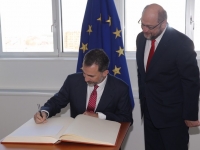Politics
Philip VI: one year on the throne
This Friday
USPA NEWS -
Friday an year marks the enthronement of Philip VI as King of Spain. The June 19, 2014, the new monarch crown clung to the challenge of returning to the Monarchy lost prestige in recent years and regain the confidence of the Spanish people.
Objectives, according to a recent survey by the Spanish Centre for Sociological Research (CIS in Spanish acronym), has achieved. Although still suspended, in a year King Philip VI has managed to raise the note given to the Spanish monarchy since 3.72 that ended the reign of Juan Carlos I to 4.34 last month. In just twelve months, Philip VI has won the acceptance of Spanish through greater transparency of the monarchy, austerity of his reign -in keeping with the times of economic crisis-, to maintain political neutrality defines the Crown and the establishment of a new organization of the King's House.
Among the decisions taken, the expulsion of the royal family of the sisters of the King and the rupture of relations with the Infanta Cristina, accused of tax offenses in connection with the activities of her husband, former international handball player Inaki Urdangarin of FC Barcelona, they have been well received by the Spanish people. It all started with the announcement of the abdication of the former King Juan Carlos I, on June 2, 2014, and four symbolic gestures that took place between the 18th and 19th of the month, before the coronation of Philip VI.
The first act was the signing of the decree of abdication by King Juan Carlos I. The second, the embrace between the outgoing king and even then Prince of Asturias, immortalized by the cameras worldwide. The third gesture was the exchange of chairs for the photo, symbolizing the transfer of the throne to the new monarch. And the fourth, the family photo: three generations of kings -Juan Carlos I, Philip VI and the new Princess of Asturias, Leonor de Bourbon- and two queens, Sofia and Letizia.
Those five people and Infanta Sofia, youngest daughter of King Philip VI and Letizia, integrate the new Spanish Royal Family. A family that came down stairs to approach the Spanish in every way. Queen Letizia still buying her clothes at department stores and stays true to its designers always. The Princess of Asturias and the Infanta Leonor studying in their school life, the same where he studied his father but in the classroom and sharing recess with children of 'normal' families.
But not all. For the first time in the history of Spain, the Crown shall be submitted each year to an external audit to certify the use of financial and material means that Spain offers its Kings. In addition, Philip VI's salary dropped by 20% to 234,204 Euro per year. And the Royal Family is prohibited from accepting gifts that could "compromise the dignity" of his job or receiving "favors or services on favorable terms."
Because Philip VI was very clear from the beginning of his reign that the Crown is not a privilege but a service to the people. And in that, the King of Spain approved with flying colors. The most important since the coronation of Philip VI year is undoubtedly his work as King of all Spaniards. In the past twelve months he has visited the 17 Spanish regions and has met with all the presidents of the regional governments, more with the president of Catalonia, Artur Mas, who defended the independence of their region.
It has also met with leaders of the main political parties in Spain and visited the European institutions, along with the Vatican, Morocco and France, his first international destinations. It has also met with the US President, Barack Obama, and has close ties with Latin American countries. He has made 16 official trips, has pronounced 119 speeches, has held 101 hearings and has participated in 152 official events.
Liability for this article lies with the author, who also holds the copyright. Editorial content from USPA may be quoted on other websites as long as the quote comprises no more than 5% of the entire text, is marked as such and the source is named (via hyperlink).






